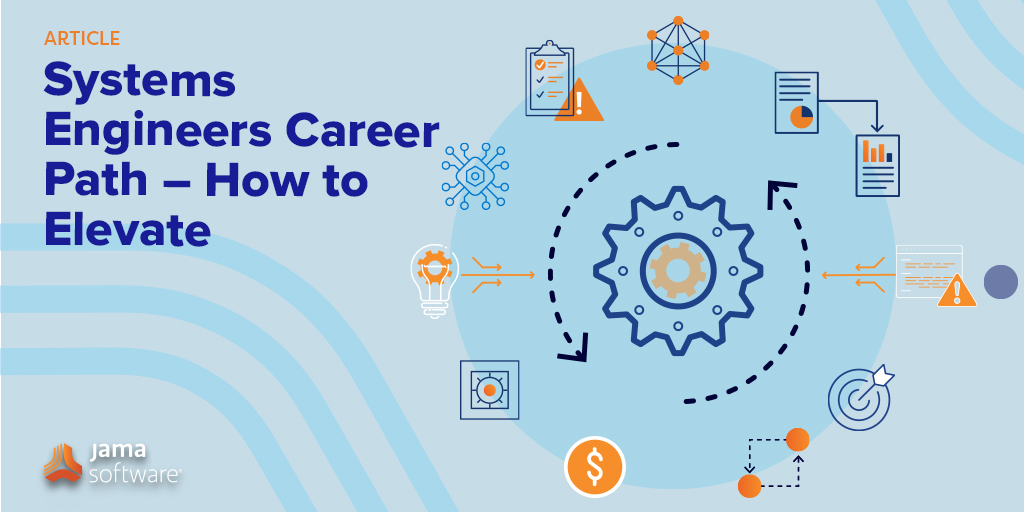Systems Engineers Career Path
Most Systems Engineers we speak with have a common perspective on their role within their organization. Systems engineering as a concept is understood and supported by leadership. And, if systems engineering best practices are followed across all engineering disciplines, leadership also acknowledges the benefits the organization can realize. However, leadership will not force change on engineering disciplines (software, hardware, electrical, risk, verification, and validation) to remove barriers to systems engineering best practice adoption. This leaves most Systems Engineers in the challenging position of possessing responsibility for achieving systems engineering benefits without the authority to ensure engineers adopt best practices.
The good news is that there is a way out of this situation. The first step to elevating your career is to realize that managing the product engineering process through data is the key and that the Systems Engineering role is the natural role to lead this. For most organizations, the product engineering process is the only process in the company that is not managed through data. No one can go to a system and see the status of all product requirements and where development, integration, risk, and testing stand at any point in time. There is no way to manage by exception. There are no alerts that requirements are not covered, test cases are missed or that hardware made a change that now impacts software. Most organizations have come to accept this state of affairs and try to manage the process through endless meetings, emails, and Slack messages.
Until the product engineering process is manageable through data, Systems Engineers will be stuck in their current trap — endlessly trying to address issues after the fact, holding unwanted meetings, and the uphill battle of trying to persuade changes in behavior. Below is a 3-step approach that Systems Engineers we work with have used to solve this organizational challenge and have thereby elevated their careers. As with any process change, it is best to do it in stages. You can start with the following steps.
- Baseline current process performance
- Build the business case for change to gain support
- Deliver quick wins
RELATED POST: How to Overcome Organizational Barriers to Live Requirements Traceability
Step One | Baseline Current Traceability Performance
The first step towards moving the organization to manage the product engineering process through data is to baseline current process performance. The best place to focus the baseline effort is on traceability since it spans the entire product development process, is a data management concept that is understood, enables systems engineering benefits, and is required by industry standards. To ease the baselining effort, we’ve developed a Traceability Diagnostic that you can use to assess your current situation. The Diagnostic inventories traceable data, the systems in which they reside, and your current Traceability Score™. This is a few-hour effort and forms the basis of the business case in step two.
In this no-cost, guided process, we’ll help you:
- Understand the monetary risk of your current Traceability Debt™
- Uncover the quantifiable ROI of moving to Live Traceability
- Develop a clear plan of action, cost, and timing to achieve Live Traceability
To Get Started With Your Free Traceability Diagnostic, CLICK HERE
Step Two | Build Business Case for Live Traceability™
Once you have established a baseline, it is now possible to build a business case for change that will resonate with leadership. Based on your baseline, the Traceability Diagnostic determines the probability of negative product outcomes (defects, delays, rework, cost overruns, etc.) and the magnitude of these events. This quantifies the risk of maintaining the status quo and doing nothing. In addition to the risk reduction potential of Live Traceability, the Diagnostic also calculates the engineering productivity gains from eliminating the need for time-consuming, manual, after-the-fact traceability efforts.
Step Three | Start with Quick Wins
Once you have secured support to move forward, it is common to be able to deliver some quick wins to the organization shortly after project kick-off. The typical place to start is the painful and time-consuming after-the-fact traceability efforts. For example, continuous syncing between requirements and software development task management in Jira or Azure DevOps can be set up quickly to automate traceability from requirements to user stories, eliminating a large source of risk and manual, after-the-fact traceability effort. Once quick wins are shown, organizational momentum increases even further and puts you on the success path to begin managing the product engineering process through data.
Clients of ours that have taken this approach have received significant recognition, been promoted into roles with greater leadership, and have increased their external visibility through speaking engagements. Live Traceability is a unique opportunity to elevate one’s career. Don’t miss the chance.
